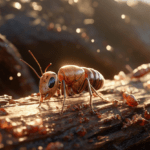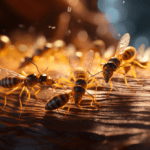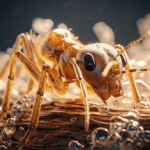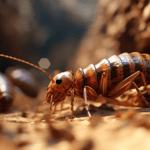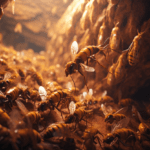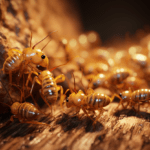Termites are small, wood-eating insects that can cause significant damage to homes and structures. To understand what termites eat, it’s important to delve into their dietary habits. Termites have specific preferences when it comes to their food choices, and their diets can be categorized into different types.
Note: For a deeper dive into this topic, don’t miss our previous article on Termite Diet Facts: What You Need to Know.
Cellulose-Based Diet
One of the main components of a termite’s diet is cellulose. Cellulose is found in various materials, including wood, grass, and plants. Termites have special enzymes in their digestive systems that allow them to break down cellulose and extract nutrients from it. The presence of cellulose in a substance is often a key determinant of whether termites will consume it. Wood, being rich in cellulose, is a highly desirable food source for termites.
Non-Cellulose-Based Diet
While cellulose is the primary dietary component for termites, they are not solely restricted to cellulose-based sources. Termites can also feed on materials such as paper, cardboard, and fabric that contain alternative sources of nutrients. These materials may not be as rich in cellulose as wood, but they can still provide sustenance for termites.
Hybrid Diet
In some cases, termites may consume a combination of cellulose-based and non-cellulose-based materials. This hybrid diet offers termites a more diverse range of nutrients and allows them to adapt to different environmental conditions. It’s not uncommon to find termites feeding on a mixture of wood, paper, and other cellulose-rich substances.
Factors that Influence Termite Eating Habits
Several factors influence termites’ eating habits. Firstly, the species of termite plays a significant role in determining their food preferences. Different termite species may have varying degrees of tolerance for certain materials or food sources. Additionally, termites’ dietary choices can be influenced by environmental factors such as moisture levels, temperature, and accessibility to food sources.
Signs of Termite Infestation
Knowing the signs of a termite infestation is crucial for early detection and prevention. Common indicators of termite activity include the presence of mud tubes, damaged wood, discarded wings, and hollow-sounding wood. Identifying these signs in and around your property can help you take necessary measures to address the issue promptly.
Prevention and Treatment of Termite Infestations
Prevention and treatment are key to dealing with termite infestations. Regular inspections, addressing moisture issues, and keeping wood and cellulose-based materials away from the foundation of your home can help deter termites. In cases of infestation, seeking professional assistance is recommended. Professional exterminators can employ a range of treatment options, including bait stations, liquid termiticides, and fumigation methods, to effectively eliminate termites from your property.
Why do termites primarily eat wood?
The primary reason why termites primarily consume wood is the high cellulose content present in it. Cellulose provides termites with the necessary nutrients for their survival and growth. Additionally, wood is abundant in most environments, making it an easily accessible food source for termites.
What types of wood do termites eat?
Termites are not picky eaters when it comes to wood. They can consume both hardwood and softwood species. Common examples of wood preferred by termites include pine, spruce, cypress, redwood, and oak. However, it’s important to note that termites can infest and feed on any wood structure, regardless of the type of wood used.
What do termites avoid eating?
While termites can consume a wide range of cellulose-based materials, there are certain substances they tend to avoid. Termites generally avoid consuming woods with high levels of natural oils or resin, such as cedar and redwood. Additionally, pressure-treated wood that has been treated with chemicals to deter termites may also be less appealing to these pests.
Here’s what termites eat besides wood
[youtube v=”gTzKyuZNDMA”]
Termites are notorious for causing millions of dollars in damages to homeowners every year. While it’s common knowledge that they readily feed on wood, it may come as a surprise that termites are capable of chewing through various other household items. In a recent web series by pest management experts, they explore the extent of the damage caused by these hungry insects.
According to the experts, termites can devour a wide range of materials made from cellulose, which is the main substance found in plant cell walls. Besides wood, termites can be found feasting on items such as shoes, books, electronics, and even money. This discovery has shocked many, as these household objects are not typically associated with termite infestations.
To investigate further, a team of entomologists at the National Pest Management Association looked into the reasons behind termites’ diverse diet. They found that cellulose is present in materials like wood, cotton, and paper, making it an easy target for termites. This knowledge allows homeowners to better predict what items might be at risk of termite damage.
In one interesting experiment, termites were introduced to a fast-food meal consisting of a burger and fries. Surprisingly, the termites quickly devoured not only the wooden burger holder but also the fries. This demonstrates that termites have the potential to eat through a wide variety of everyday household items.
Knowing the extent to which termites can cause damage is critical for homeowners. In some cases, termites have been known to completely eat through the cover of a dictionary, from front to back, including all pages. They have even been observed making their way through a book from A to Z, ultimately leaving nothing behind.
The web series, which aims to educate and entertain viewers, provides a fun and humorous way to learn about the eating habits of termites. By raising awareness about these unexpected targets, homeowners can take necessary precautions to protect their belongings from termite infestations. Ultimately, understanding what termites eat besides wood can help prevent costly repairs and ensure a termite-free home.
Conclusion
Understanding the dietary habits of termites is essential in preventing and addressing termite infestations effectively. Termites primarily feed on cellulose-based materials, with wood being their main food source. However, they can also consume other non-cellulose-based materials. Factors such as moisture levels, accessibility, and environmental conditions play a significant role in their eating habits. By being aware of the signs of a termite infestation and taking preventive measures, you can safeguard your property from these destructive pests.
FAQs
- Can termites eat through concrete?
No, termites cannot eat through concrete. However, they can build mud tubes on the surface of concrete to access wood or other cellulose-based materials. - Are termites attracted to certain types of wood more than others?
Termites do not have specific preferences for certain types of wood. They can infest and feed on both hardwood and softwood species. - How long does it take for termites to cause significant damage to a structure?
Depending on the size of the termite colony and environmental factors, termites can cause significant damage to a structure within a few months to a few years. - Can termites survive without food?
Termites cannot survive without a food source. They rely on cellulose-containing materials for their nutrition and survival. - Can I treat a termite infestation on my own, or should I seek professional help?
While some DIY termite treatments may show temporary results, it is highly recommended to seek professional help for effective and long-lasting termite control.
- Mastering Leader in Spanish: The Complete Guide - April 19, 2025
- Uncovering Surprising Parallels: England Size Compared to US States - April 19, 2025
- Old Mexico Map: Border Shifts 1821-1857 - April 19, 2025

